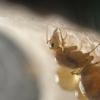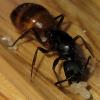So I have been a minor participant on the anting forums for the past 3 years. I have read everything I could on what kind of substrate to use in a thin vertical nest, however, the best I have been able to find is some custom mixtures of sand/dirt/peat/substrate clay. Everyone seams to say that it is best to make test batches and see which ones you like best to protect against collapse but still be malleable enough for the ants to dig and prevent (as much as possible) the ants ability to stick the material to the galls and block my view. Currently my tests have shown me that the best mixture so far is 1 part powdered bentonite clay to 9 or 10 parts reptile sand from PetCo. I have treid adding coconut fiber etch as well but I did not see any benefit to adding it to the mixture, the sand and clay by itself did a great job of holding moisture and I don't think it needs the added moisture holding abilities of coconut fiber.
So long question not so short, do any of you have any other advice or tips for me? I want to use a substrate nest because I am most interested in the ants natural digging/nest architecture behavior and pre-molded nests will take out must of the fun of the hobby for me. I have a cacophonous colony in one of the large tarheal founding chambers with 20+ workers that I am going to connect to my newly constructed thin nest within the next month or so, but I want to make sure I fill it with a good substrate that will work.
Thanks for the help!
-Zach





















